The Class-A Amplifier Site
This page was last updated on 20 July 2001
Class Distinction in Audio Amplifiers
A discussion of design problems and how to overcome them
by J. L. Linsley Hood (1)
(Wireless World, June 1970)
Since the publication of "Simple Class A Amplifier" the author has received numerous letters asking whether it would be feasible to increase the power output to 15W, or even 20W, to provide a greater reserve for use with inefficient loudspeaker systems.
Whilst it would be possible, the problems associated with increased heat dissipation and the provision of suitable power supplies makes this unattractive. In view of the low average power required for normal listening, the question inevitably arose whether it would be practicable to design an output stage which would operate in class A with an inherently low level of high order distortion up to a watt or two, but progress further into class B operation if and when higher powers were momentarily demanded.
There are, unfortunately, a number of snags with the class B operation of transistor output stages, to which the answers are not fully known.
It was pointed out some years ago, by Bailey (2) and others, that the use of quasi complementary symmetry in such output stages led to an increase in high-order harmonic distortion, associated with the non-linearities in the crossover characteristics at low volume levels, and although the level of total harmonic distortion at maximum power output could be quite low, the distortion content at typical listening levels could be many times greater than this, and would also be of an audibly objectionable type.
A number of schemes have been proposed to overcome this problem, including the use of full complementary symmetry (2 3 4), and various methods of ensuring that there are an equivalent number of forward biased junctions in each limb have been described (5 6), including the ingenious semi-complementary triples arrangement used in the "Quad" amplifier (7).
However, in the author's experience, some class B transistor amplifiers - including those employing full symmetry, which is presumed to eliminate the major fundamental snags of this type of operation - having an impeccable performance on paper, did not have the tonal quality which had been expected. Since harmonic distortion at both high and low power levels had been found to be well below the level at which audible effects might reasonably be expected in some of the designs tested, it seemed more probable that the audible ill-effects were due either to transient instabilities associated with loudspeaker loads -perhaps related to changes in the reactance of the base-emitter junction at the current cut-off point - or to high-frequency crossover type distortion arising from hole-storage effects. Hole-storage depends on the presence of holes produced when current flows in a semiconductor - even though the current is due to majority carriers (electron flow). The greater the current the greater the number of holes and the worse the problems of hole storage.
Hole-storage phenomena
The expected result of hole storage in the base region of a transistor, following the attempted termination of a high emitter collector current, is that the transistor remains in a conducting state after the forward base bias has been removed. This has the effect, amongst other things, that the normal crossover discontinuity shown in Fig. 1(a) becomes displaced from the mid-point of the transfer waveform as the frequency is increased, as shown in Fig. 1(b).
These waveforms were generated in a simple complementary pair emitter-follower circuit, without additional negative feedback, driving a resistive load. (In order to assist its display the crossover effect was deliberately exaggerated by the use of an inadequate quiescent current.) Provided that the peak currents flowing through the transistors are small, this effect is innocuous. However, if the peak currents are increased, by reducing the load resistance, the crossover waveform rapidly deteriorates as shown in Fig. 1(c), and increasing the forward bias to give a more suitable quiescent current has little effect in removing this prominent notch, until the forward bias is almost equivalent to that of class A operation.
It is known from experience that these effects can be minimized by the use of transistors with good high-frequency characteristics and low-impedance base-emitter return paths. A low-impedance driver stage will also be effective provided that it does not become cut off (as in the case of the Darlington pair) when the input signal reverses polarity.
The effect of reducing the driver circuit impedance from 2000ohm to 100ohm is shown in Fig. 1(d).
The lack of effective symmetry between the upper n-p-n device and the lower p-n-p is also shown in Fig. 1(c). This effective asymmetry is reduced if the source impedance is reduced.
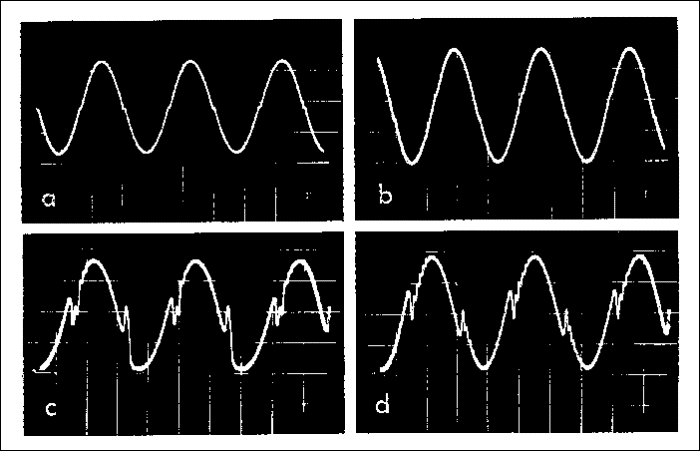
Fig. 1. Crossover distortion in a class B stage employing transistors with an fT of about 2MHz. (a) Low frequency sine wave at 10mA. (b) High frequency sine wave showing the effect of hole storage on the crossover discontinuity under light load conditions. (c) Influence of hole storage and n-p-n/p-n-p asymmetry under high current conditions at 200kHz. (d) Improvement of conditions in (c) by reducing source impedance.
It was noted that this effect did not become apparent, even under high emitter current conditions, until the operating frequency approached 0.05 fT. At 0.1 fT, the problem was severe and this argues that the occurrence of high transient currents - which may arise with certain loudspeaker systems - and high driver stage output impedances, is most undesirable unless the highest frequency components of the waveform are low in relation to the transition frequency of the output transistors. With the availability of power transistors having transition frequencies of the order of 4MHz (such as the MJ480/490 series) it is unlikely that hole-storage phenomena will be troublesome at the rates-of-change of signal voltage likely to be encountered in audio amplifier practice so long as the driver stage does not leave the output transistor base open-circuited on cut-off. However, the use of a driver output, or base circuit, impedance not in excess of a few hundred ohms appears prudent. With earlier designs using germanium diffused junction power output transistors, which usually have very poor h.f. performance, this problem could be important, and Dinsdale has referred to a "subjective audible improvement" resulting from the replacement of low transition frequency output transistors with types having better h.f. characteristics.
Transient instabilities on loudspeaker loads
Phase-angle measurements made with a variable frequency sine wave input, from a high impedance source, reveal that even a simple single-unit loudspeaker can present quite complex characteristics. The reactance - which is normally inductive - changes rapidly, and sometimes even becomes capacitive, at frequencies in proximity to cone and structure resonances.
In general, the characteristics of most of the common designs of transistor power amplifiers are such that instability problems do not arise with inductive loads, and the inclusion of a small choke, of a few microhenries inductance, in the speaker output lead is a well known technique for avoiding instabilities under adverse load conditions. However, capacitive loads can frequently impair the stability margins of the feedback loop, and it is in this respect that
the reactive characteristics of the loudspeaker load are most significant Since it was suspected that the region of the output waveform where this might arise most readily was that at which the output transistors were being driven from the conducting to the cut-off state, an input waveform which provided a transient of controllable steepness (by varying the input amplitude), but arrested at the mid-point, was provided by the circuit of Fig. 2.
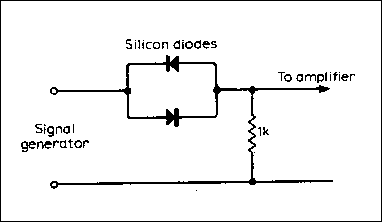
Fig. 2. Circuit for generating the test waveform shown in Fig.3.
The waveform generated by this device is shown in Fig. 3 and the result of introducing such a waveform into an amplifier of poor stability margins, coupled to a resistive load shunted by an appropriate value of capacitance is shown in Fig. 4(a). (The broadening of the oscilloscope trace in the horizontal regions at the mid-point of the waveform was due to inadequately recorded h.s. oscillation.)
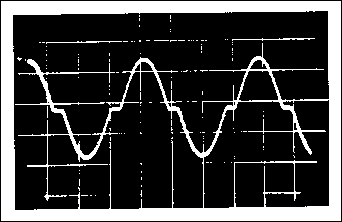
Fig. 3. Test waveform for providing arrested transient input.
The output waveform obtainable from a design with better stability margins and improved bandwidth is shown in Fig. 4(b). In both cases the magnitude of the input signal was adjusted so that clipping occurred on both negative- and positive-going peaks.
Since the h.f. instability shown in Fig. 4(a) - which did not occur in the absence of a large input signal, and which required a particular range of shunt capacitance to provoke it at all - also occurred on parts of the waveform preceding the arrested transient, it was concluded that the change in reactance of the base-emitter junction at cut-off or switch-on, was not a major cause of the transient induced instability observed in this particular design.
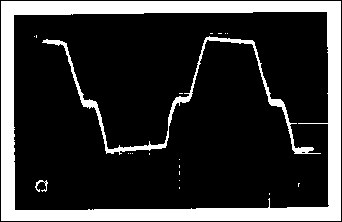
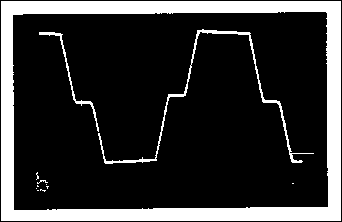
Fig. 4. Amplifier performance using 10kHz test waveform. (a) Response of amplifier showing inadequate stability with reactive load. (b) Response of improved amplifier with reactive load.
Square-wave performance and tonal quality
In view of the fact that a loudspeaker system can present a reactive load, of a type which is found in certain circumstances to cause signal induced instability, and since this instability could be provoked by a square-wave input into an amplifier with a suitable reactive load, a series of tests and comparative listening trials was conducted to determine whether there was any audible relationship between the two. In the event, it was found, beyond doubt, that an amplifier system which did not show any sign of instability over the range of load shunt capacitances up to, say, 0.33uF had a better tonal quality on even a simple loudspeaker system than one in which some shunt capacitor value could cause h.f. oscillation. Moreover, in a more complex loudspeaker system, with a crossover network and high-frequency capacitively coupled "tweeter", it was possible to hear the difference between systems which would, in the lab., with some RC load combination, give a square-wave response such as that of Fig. 5(a) and those which had a response like that shown in Fig. 5(b). No positive distinction could be drawn in listening trials between a system giving a waveform such as Fig. 5(b) and one in which a square-wave input could produce a single overshoot "spike".
Since the frequency of the "ring" waveform in Fig. 5(a) is well beyond the upper limits of the audible spectrum, it is clear that it is not this of itself which produces the undesired sound quality, but rather that this type of behaviour is symptomatic of a different and more objectionable effect when the amplifier is used with a loudspeaker load.
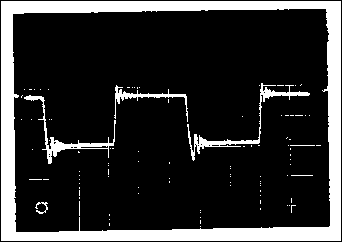
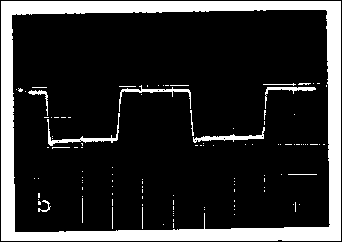
Fig. 5. Amplifier response driving a reactive load (15ohm, 0.47uF) with a 10kHz square wave.
(a) The ringing gives evidence of instability. (b) No transient ring indicates better stability.
The conclusions which have been drawn from this series of experiments are these: (1) that it is desirable to employ output power transistors in which the transition frequency is at least ten times higher than the highest signal frequency component which is passed to the amplifier from preceding stages; (2) that it is preferable to drive the output transistors from a source which has a low impedance over the whole signal voltage swing, or at least to provide a reasonably low-resistance base-emitter current path; and (3) that the phase/frequency characteristics of the feedback loop should be such that a square-wave output devoid of overshoots is obtained when the amplifier is bench tested with a wide range of shunt capacitance values in an RC dummy load. This latter requirement probably implies either a fairly limited number of stages within the feedback loop or a relatively restricted h.f. bandwidth.
When these requirements had been met, and when the harmonic distortion levels over the range 40mW up to the maximum rated power output were of a suitably low level, there was no audible difference, in the most careful listening trials, between several different designs. However, it is difficult in class B systems to obtain the desired low level of harmonic distortion at low signal levels without the use of substantial amounts of negative feedback, and this leads to a worsening of the amplifier response to signals containing transients.
The use of a class AB system, if the problems in maintaining the correct forward bias level can be solved satisfactorily, should facilitate the attainment of these desired standards, particularly if the h.f. negative-feedback loop can be made fairly simple.
Next month full details will be given of a 15-20W class AB amplifier with the following characteristics:-
Power output: 15W into 15ohm, or 18W into 8ohm (20W with modified output circuit component values.)
Bandwidth: 10Hz-100kHz +/- 0.5dB at 2V output; 20Hz-50kHz +/- 1.0dB at maximum power output.
Output impedance: 0.03ohm (at 1kHz).
Total harmonic distortion: 0.02% at 15W/15ohm or 18W/8ohm; less than 0.02% at all power levels below maximum output.
Intermodulatlon distortion: Less than 0.1% at 10W (12.3V r.m.s. into 15ohm) and 70Hz, and at 1V r.m.s. at 10kHz.
Square-wave transfer distortion: Less than 0.2% at 10kHz.
REFERENCES
1. Linsley Hood, J. L., "Simple Class A Amplifier", Wireless World, April 1969.
2. Bailey, A. R., "30-watt High Fidelity Amplifier", Wireless World, May 1968.
3. Williamson, R., Hi-Fi News, Feb.1969, pp. 320-329.
4. Hardcastle, I., and Lane, B., "Low-cost 15-W Amplifier", Wireless World, Oct. 1969.
5. Shaw, I. M., "Quasi-complementary Output Stage Modification", Wireless World, June 1969.
6. Baxandall, P. J., "Letters to the Editor", Wireless World, Sept.1969.
7. "Low Distortion Class B Output", Wireless World, April 1968.
HISTORY: Page created 20/07/2001